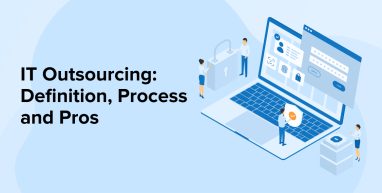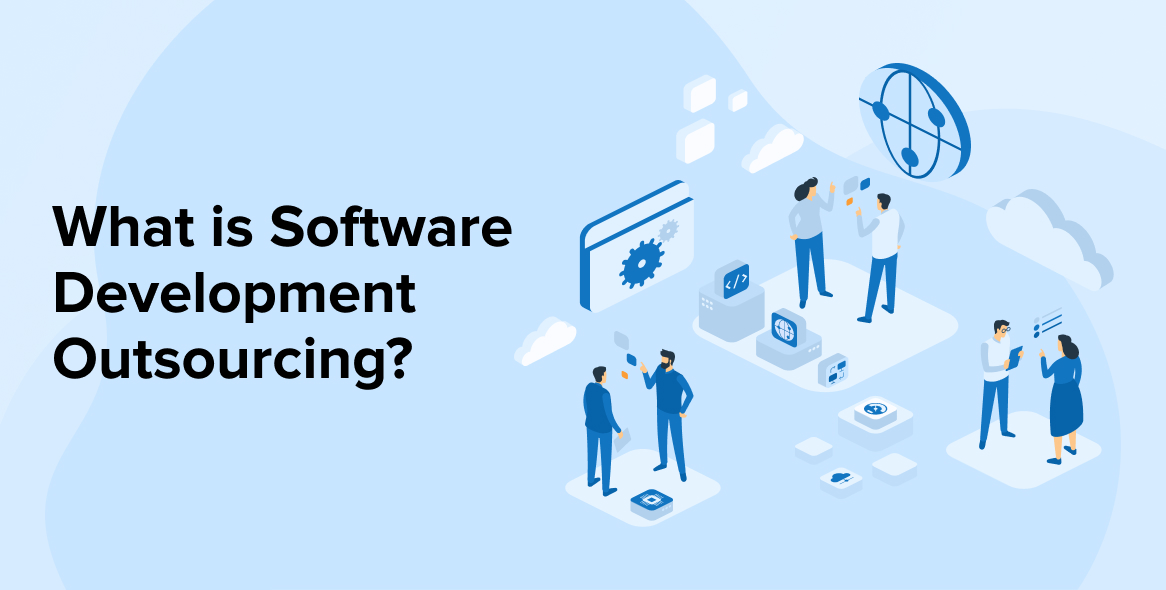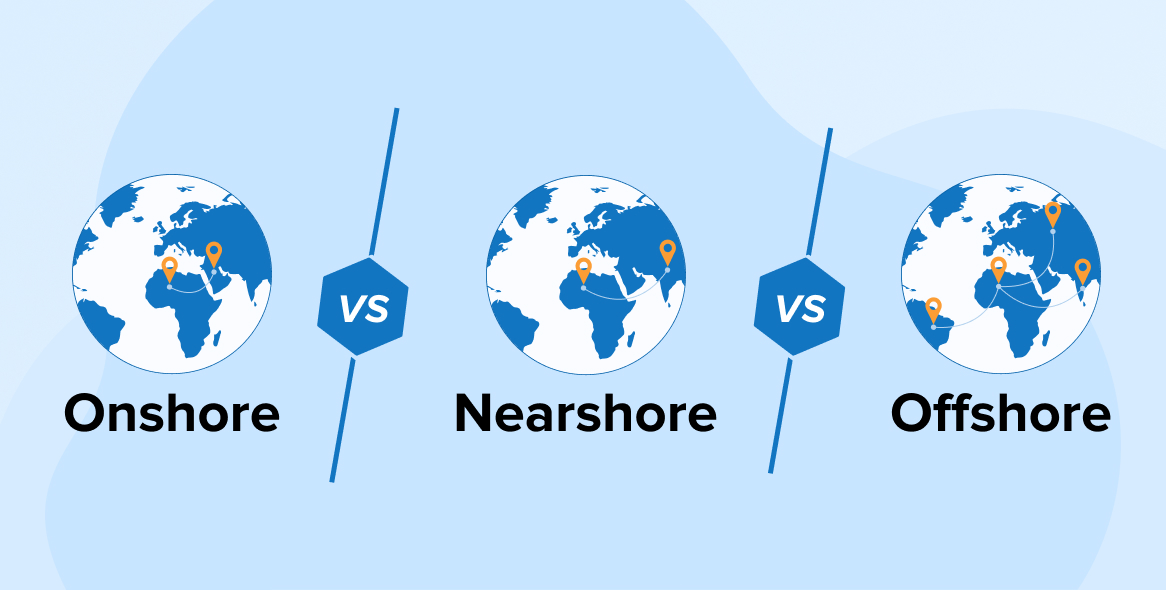
Businesses around the world are dodging the race with market-advanced tools and technologies to sustain. But there is continuous hustle among all sizes of businesses and industries to stay ahead of the competition and accelerate their revenue streams. Specifically, if we go by facts and talk about the IT Outsourcing sector, Statista has clearly stated the outsourcing market has been snowballing.
1. What is IT Outsourcing?
IT outsourcing is a business practice of escalating multiple software business requirements to external service providers who are experts or have experience in delivering software solutions and meeting quality benchmarks. The IT outsourcing business started as a cost-saving activity and has now dramatically grown into a trend for businesses to explore untapped outsourcing benefits and gain access to the right talent.
IT outsourcing can be defined as a holistic process of shaping the future of a business with software service offerings, managing IT infrastructure, creating robust design apps, strategizing development, and running multiple service desks.
This is not just the management of one process or project but it is inclusive of multiple smaller tasks. The IT outsourcing company takes complete responsibility for software from ideation, designing, development, testing, deployment, up-gradation, and maintenance services. The tech support provided by software outsourcing companies can be project-based, fully managed, co-sourced, or usually by augmenting facilities through skilled resources of third-party IT outsourcing providers.
It outsourcing is heighten with a net worth of 139.90 million dollars in 2020 from 92.5 million in 2020 – source.
1.1 What IT Services are Mostly Outsourced?
The part of IT services is not limited to a single technology offering or service because there are many functions that can companies outsource at a lower cost. IT services encompass a huge part of IT businesses which is inclusive of many unexplored services that businesses may need at any time and instance. Some of the largely used and outsourced software development services are
- IT Development Services or Software development: Managing the Development process of any type of complicated software in all the phases of the SDLC life-cycle.
- IT Consultancy Needs: Assisting continuously businesses to guide them to manage specific IT needs of businesses with ease.
- IT Security Services: Providing safety and security to businesses from Viruses, Spam, and other Online threat protection.
- Managed IT Services: Offer timely services for Server hosting and application Hosting.
- IT Infrastructure Services: Includes all types of software, hardware, network installation, and other technical infrastructural services.
- Data Center Activities: Data management activities from data fetching, data center outsourcing sorting, processing, and storage.
- Strategic Planning and Association: From ideation to strategic planning, to implementation and association- all the planning needs are catered to in this phase.
- Data Backup and Disaster Recovery: Data is information, and now most of the processes are dependent on data so safeguarding data is extremely important.
IT Outsourcing has been transforming businesses at a breakneck pace with innumerable service offerings that it offers to its clients. Now, that we understand how businesses have been taken over by the needs of IT, hence it is imperative for all businesses to collaborate with IT outsourcing companies to progress and pave a successful path ahead. Businesses can engage with other businesses based on specific methods. Outsourcing gives you a competitive advantage against your competitors and also enhances the performance of in-house teams.
1.2 Advantages of IT Outsourcing
Now that you know the type of engagement models, it’s now time to understand what perks can a business leverage if you decide to be a software outsourcing company. There are countless benefits of outsourcing to third-party providers that are offered to businesses with IT-managed services or software outsourcing service providers.
- Cost Benefits: IT Outsourcing works on a contract basis, and hence there is a fixed budget to keep companies informed about the service expenditure. This will help businesses to invest in some other operations while getting benefited from this process. Outsourcing enables businesses to lower labor costs, operational costs, and maintenance costs.
- Saving Time: With software outsourcing, the tasks are performed simultaneously which allows the current company to work on other vital issues of the company while IT is managed by experts.
- Access to More Talent: A key benefit of IT operations outsourcing is that there is no restriction on the workforce, there are many people that can be accessed through onshoring, offshoring, and nearshoring models. Information Technology Outsourcing enables companies to integrate external expertise with their internal resources. Outsourcing gives access to developers possessing world-class capabilities and technical skills.
- Consistent Results: Outsourcing companies have already delivered success to many businesses and so they have the proficiency and expertise to deliver perfect business outcomes.
- Speedy and Scalable Resources: Access to the right set of resources improves the hiring process and offers convenience and flexibility to ramp up and down resources as per the need.
- Innovation at Center: With creativity and innovation taking center stage for each activity in IT outsourcing, they allow businesses to bring novelty in the market space.
2. Different Types of IT Outsourcing
Depending on the business needs and convenience, they decide to outsource. These needs can be depending on long-term planning or to achieve short-term goals. The cross-border trade pattern has offered companies to harness a younger pool of expertise and capabilities. Companies work with third-party providers so their IT functions respond quickly to changing demands. An outsourcing model is confined to three major factors i.e. the location of the outsourcing company, the type of partnership they offer, and the outsourcing contract details.
It is important to uncover the forms of outsourcing approaches for software creation from a broad list of resources we see. When businesses are contemplating other businesses of the same genre and the same type of offering, it is important to select one type of model from many. A company may use one service provider for all outsourcing requirements or multiple vendors to provide different elements. The three major types of outsourcing models, are Offshore, Nearshore, and Onshore outsourcing.
2.1 Offshore Outsourcing

Offshore outsourcing is a location that is far away from the client’s location, mostly in a different continent or geography but is chosen as an offshore destination because it satisfies business needs of optimizing the overall business process. This cooperation model of outsourcing is an aid to maximize the total budget and prefers to recruit talented resources from a multinational pool of hourly wages or monthly charges. As there is an additional advantage of time overlap during e-meetings and internet calls, certain business time zones play an important part in remote work. The project manager from the outsourced team takes responsibility for the quality and performance of the project.
2.2 Nearshore Outsourcing

Nearshore Outsourcing goes as per the name where the outsourcing location is the nearest geographic location promising easier operations. The outsourced tasks/projects would be carried out by the citizens of the country or from the surrounding countries. In Nearshoring, the countries within the restricted vicinity are chosen with a fundamental objective of traveling whenever desired and easy to fly. The culture and method of working will be much similar compared to other models.
2.3 Onshore Outsourcing

In this type of outsourcing, the company will work with any other software development within the same country. Any type of business engagement will be between two companies located within the same geographic region. There is high demand for onshore outsourcing because it reduces the costs of traveling and saves time. Global companies mostly prefer this outsourcing model because of the same time zone and cost reduction. There won’t be any cultural differences, the same type of holiday list, people, and method of working.
3. Financial Engagement Models of IT Outsourcing
Following are the financial engagement models of IT outsourcing:
- Fixed Cost: The fixed-cost pricing model is not implemented based on assumptions but instead, there is a strategic payment process involved which is fixed and charred as per the deliveries. Companies’ changing needs are observed, recorded, and matched accordingly with service offerings. These resources can include everything from custom software creation, development of smartphone applications, development of websites, or some other cutting-edge services for software development. It is always advisable to discuss the norms before deciding the scope of the engagement.
- Dedicated Development Team: For the Dedicated development team, there is a specialized team of software designers, developers, and other professionals hired for a specific time period and with particular technical expertise. In the dedicated team model, your outsourcing vendor provides you with all the staff which is required to complete your project. In this process, the customer is paid according to the services provided. The services are based on qualifications, knowledge, and competence, as per the project requirements. A dedicated team will be more engaged with your project as compared to others. The client organization will handle its cost on its own and even appoint a manager within their company to report to them. The tools can either operate at the clients’ location whether the customer wishes, or can work remote location.
- Time and Material: The Time and Material model applies to all consumers who choose a versatile price model. This form of pay-as-you-go encourages consumers to pay according to the assignments shipped. For organizations where needs continue to evolve and there is no long-term target, this is a natural match. There are short-term priorities that the organization needs to follow.
4. Do/ Don’ts of IT Outsourcing in Software
Now that we know the type of IT Outsourcing models and the importance of engagement with the best-of-breed business. To elaborate more, we have assimilated software outsourcing best practices to assist businesses with what to do and what not to do when they decide to outsource business functions. Based on our learnings, we have sieved out a few noteworthy points that should be considered in DO and Don’ts. Let’s start with some of the necessary DOs first.
4.1 Essential DOs in IT Outsourcing
- The first and foremost thing to keep is to discover the best-fit method for your Outsourcing needs that aligns easily with the organization’s agendas.
- Secondly crisply pen down the project specification, implementation strategies, and forecasted outcomes.
- Design an achievable plan with the end-product decided.
- Should be thorough with the talent source getting collaborated to.
- Checklist a group of companies that fits the need.
- Communicate and filter out unnecessary choices.
- Make personal and professional communication with the partnered team.
- Monitor work at regular intervals for a timely status update and record-keeping of project progress.
- It is essential to sign outsourcing agreements to avoid security issues.
Now that we have understood some key points that must be taken care of while deciding to partner with a third-party company or are already in collaboration with one. Now let’s go to the essential points that should be taken into consideration but not implemented.
4.2 Essential DONTs in IT Outsourcing
- The first and foremost action is to take care of your tasks even after outsourcing and not blame the company after everything is over.
- Also, most businesses are in a dilemma that the software development company offers a fixed price for everything. This is a myth, so do not consider one price fits all, instead understand all varying needs have distinct prices.
- There is no shortcut to software development, it needs effective management and constant monitoring.
- Being intuitive to change the work culture of the partnered software development company.
- Do not outsource something you are already good at.
5. To Wrap Up
Time has certainly taken a toll on businesses which makes them dependent on experts for their internal operations. In this blog, we have gone through the in and out of the software Outsourcing business and its methods, process, and needs. IT Outsourcing is a business strategy working for years and has benefitted businesses through multisourcing options through vendors. Gain superior services and higher value of money by choosing the right partner for all your business services and offerings. So, think and partner.





This is a perfect guide for anyone who wants to understand about IT Outsourcing. It explains every aspect of IT Outsourcing in detail and gives some valuable information. I think it can also include information about the cost of outsourcing.
Yes, you are right, the cost of IT outsourcing is the most important and essential factor while considering outsourcing. Hence it is very important to consider all the factors which affect the cost of outsourcing.
This article has been written very nicely. It tries to cover all important aspects of IT Outsourcing. Most engaging fact about this guide is it will not bombard a lot of information on you. Article discusses every topic in optimal length.